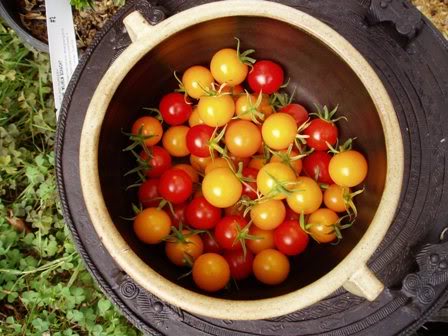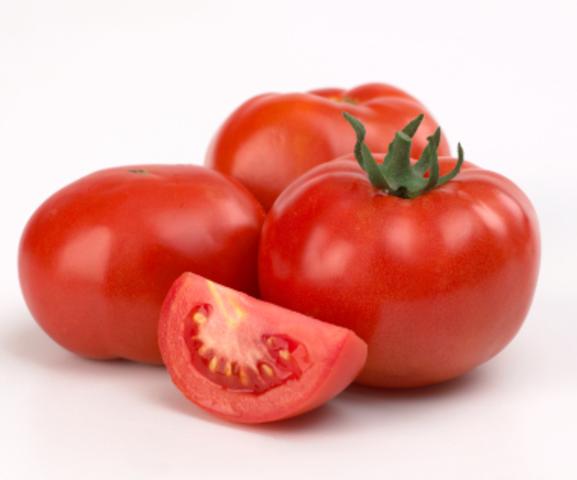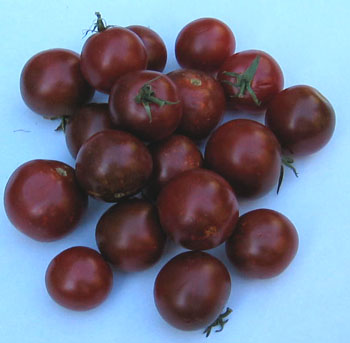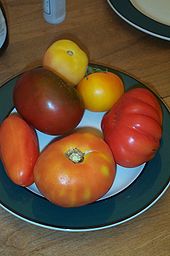|
Tomatoes are acidic, sweet, tangy and juicy, delicious and inexpensive Tomatoes (Solanum lycopersicum) come in an array of colours and sizes. Most of us think of this as a red vegetable but it is a fruit and the colours vary widely. They can also be yellow, orange, green, white, nearly black or brown and various shades of maroon-purple. Some are single coloured, speckled, stripped or multi-coloured. They are known as the ‘Red Bodyguard’ because of their health promoting properties. Is size everything, not at all, at least not where this fruit is concerned. The smallest fruits are referred to as currants, then there are the cherry, small and round. Others, marketed on the vine, are called cocktail. Plum have an elongated shape, mini ones being popular for snacks because of their sweet taste. Last but not least the beefsteak. As its name suggests it is much larger than the average (10 centimetres (4 in) or more in diameter).  During each summer I grow both red and yellow cherry varieties in the greenhouse. There is nothing tastier than one just picked straight from the plant. Companion planting is the key to your tomatoes natural health. Growing your own is so much fun; they are adaptable and will grow in containers, grow-bags, in the ground as well as under cover. Plants can reach 1–3 metres (3–10 ft) in height, with flowers that are 1–2 centimetres (0.4–0.8 in) across, yellow in colour and having with five pointed lobes on the corolla. You can control the height by pinching out the growing tip. Sideshoots that form in every leaf axil (where a new branch is formed) need to be pinched out regulary to ensure maximum growth and fruit production. These sideshoots can be used to create new plants. Keep plants in a warm sunny sheltered position. Give them plenty of water and feed. Larger plants require a support, or dwarf plants might be more suitable in a smaller space. Hanging basket varieties are decorative as well as productive. They require lots of water for they tend to dry out quickly in a warm breeze. The reason for their good taste is due to over 400 volatile compounds being identified in tomatoes, 30 of which are thought to contribute to their aroma. Plenty of sunshine helps them to ripen and increase flavour. Vitamin A, B1, B2, B6, C, E and K A valuable source of vitamins as well as containing several minerals, the plant has fleshy, succulent berries rich in beta-carotene and fibre.Niacin Folate Pantothenic Acid Calcium Copper Iron Magnesium Manganese Phosphorus Potassium Sodium Zinc Beta-carotene fibre More importantly they contain lycopene, studied extensively for its antioxidant and cancer preventing properties, particularly prostate cancer. It has also been linked to the prevention of heart disease and to boosting the immune system. What is lycopene? It is a carotinoid that is found in red fruits, such as tomatoes and watermelons. Lack of antioxidants could be a cause of tiredness, depression and feeling old. They are low in calories (approx. 14 calories per 100g) and contain virtually no fat and no cholesterol. How is it possible for a tomato to sit in direct sunlight for days, even weeks, and its skin to stay wrinkle free? Basically it's down to the antioxidants in the lycopene, which protect it from the sun’s harsh rays. This is also thought to possibly strengthen our own skins defences. Protecting our cells helps slow down the ageing process and makes us feel better. When tomatoes are cooked, especially in oil, they release five times more lycopene than raw ones. Added to that, it is more easily absorbed into our system when cooked. As a certain amount of nutrients are lost through cooking (primarily vitamin C and flavonoids) it is better have some of each, cooked and raw. I use an iron skillet when cooking any type of tomatoe as this helps with iron intake. Believe it or not, canned are healthier for you, as they contain more lycopene per gram. I use them a lot when cooking, mainly in the form of passata, chopped from a tin or as mentioned earlier straight from the plant. Passata. Made from ripe tomatoes that have been puréed and sieved to remove both the skin and seeds. To make a really tasty sauce, combine with a little oil (we use Rice Bran oil), chopped onion, peppers and a few spices (turmeric, ginger, garlic).  Many people use them in stews, soups or pasta dishes and wherever you go they are an accompaniment to salads. What a fantastic way to get so many valuable nutrients; go ahead, enjoy a meal with tomatoes. The humble tomatoe is also known as the ‘love apple’. First used for food in Italy, they were called "pomme dei mori". This was corrupted during translation to French to "pomme d’amour" or "apple of love" and thought to excite the passions of people. Believed to have originated in the Andean region of North and Central South America, European explorers found them in Mexico where they had been cultivated for centuries. When they first arrived in Europe around 1523, they were considered poisonous due to their strong odour and bright white, red and yellow berries. Italian immigrants in New England, North America and French settlers in New Orleans cooked with them regularly (they introduced Ketchup in 1779).
Tomatoes belong to the nightshade family, as does the potato, aubergine, chilli pepper, paprika, tobacco and the lovely petunia. Home page - from - Tomatoes
|









